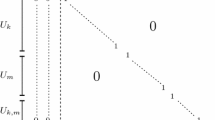Abstract
In this paper, we propose an exact algorithm for the knapsack sharing problem. The proposed algorithm seems quite efficient in the sense that it solves quickly some large problem instances. The problem is decomposed into a series of single constraint knapsack problems; and by applying the dynamic programming and another strategy, we solve optimally the original problem. The performance of the exact algorithm is evaluated on a set of medium and large problem instances (a total of 240 problem instances). This algorithm is parallelizable and this is one of its important feature.
Similar content being viewed by others
References
R. Andonov, F. Raimbault, and P. Quinton, “Dynamic programming parallel implementation for the knapsack problem,” IRISA, Campus de Banlieu, Rennes, France, Technical Report,PI-740,1993.
R. Andonov and S. Rajopadhye, “Optimal orthogonal tiling of 2-D iterations,” Journal of Parallel and Distributed Computing, vol. 45, pp. 159–165, 1997.
J.R. Brown, “The knapsack sharing,” Operations Research, vol. 27, pp. 341–355, 1979.
J.R. Brown, “Solving knapsack sharing with general tradeoff functions,” Mathematical Programming, vol. 51, pp. 55–73, 1991.
G.H. Chen, M.S. Chern, and J.H. Jang, “Pipeline architectures for dynamic programming algorithms,” Parallel Computing, vol. 13, pp.111–117,1990.
G.H. Chen, M.S. Chern, and J.H. Jang, “An improved parallel algorithm for 0/1 knapsack problem,” Parallel Computing, vol. 18, pp.811–821, 1992.
P. Chu and J.E. Beasley, “A genetic algorithm for the multidimensional knapsack problem,” The management school, Imperial college, London SW 2AZ, England Working Paper, 1997.
V.-D. Cung, S. Dowaji, B. Le Cun, T. Mautor, and C. Roucairol, “Concurrent data structures and load balancing strategies for parallel branch-and-bound/A✱ algorithms,” DIMACS Series in Discrete Mathematics and Theoretical Computer SCience, vol. 30, pp. 141–161, 1997.
A. Freville and G. Plateau, “The 0-1 bidimensional knapsack problem: Toward an efficient high-level primitive tool,” Journal of Heuristics, vol. 2, pp. 147–167, 1997.
P.C. Gilmore and R.E. Gomory, “The theory and computation of knapsack functions,” Operations Research, vol. 13, pp.879–919, 1966.
P.C. Gilmore, “Cutting stock, linear programming, knap sacking, dynamic programming and integer programming, some interconnections,” Annals of Discrete Mathematics, vol. 4, pp. 217–235, 1979.
M. Hifi and V. Zissimopoulos, “A recursive exact algorithm for weighted two-dimensional cutting,” European Journal of Operational Research, vol. 91, pp. 553–564, 1996.
M. Hifi and R. Ouafi, “Best-first search and dynamic programming methods for cutting problems: The cases of one or more stock plates,” Computers and Industrial Engineering, vol. 32, pp. 187–205, 1997.
T. Kuno, H. Konno, and E. Zemel, “A linear-time algorithm for solving continuous maximum knapsack problems,” Operations Research Letters, vol. 10, pp. 23–26, 1991.
B. Le Cun, C. Roucairol, and TNN Team, “BOB: A unified platform for implementing branch-and-bound like algorithms,” PRiSM, Universit´e deVersailles, St-Quentin-en-Yveline, 78035,Versailles, France,Working paper, 1995.
H. Luss, “Minmax resource allocation problems: Optimization and parametric analysis,” European Journal of Operational Research, vol. 60, pp. 76–86, 1992.
S. Martello and P. Toth, Knapsack Problems: Algorithms and Computer Implementation,John Wiley & Sons: New York,1990.
S. Martello and P. Toth, “Upper bounds and algorithms for hard 0-1 knapsack problems,” Operations Research, vol. 45, pp.768–778,1997.
R. Morabito and M. Arenales, “Performance of two heuristics for solving large scale two-dimensional guillotine cutting problems,” INFOR, vol. 33, pp. 145–155, 1995.
J.S. Pang and C.S. Yu, “A min-max resource allocation problem with substitutions,” European Journal of Operational Research, vol. 41, pp.218–223,1989.
M. Syslo, N. Deo, and J. Kowalik, Discrete Optimization Algorithms, Prentice-Hall: New Jersey, 1983.
C.S. Tang, “A max-min allocation problem: Its solutions and applications,” Operations Research, vol. 36, pp. 359–367, 1988.
J.M. Valéro de Carvalho and A.J. Ridrigues, “An LP-based approach to a two-stage cutting stock problem,” European Journal of Operational Research, vol. 84, pp. 580–589,1995.
T. Yamada and M. Futakawa, “Heuristic and reduction algorithms for the knapsack sharing problem,” Computers and Operations Research, vol. 24, pp.961–967, 1997.
Author information
Authors and Affiliations
Rights and permissions
About this article
Cite this article
Hifi, M., Sadfi, S. The Knapsack Sharing Problem: An Exact Algorithm. Journal of Combinatorial Optimization 6, 35–54 (2002). https://doi.org/10.1023/A:1013385216761
Issue Date:
DOI: https://doi.org/10.1023/A:1013385216761




